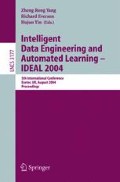Abstract
Network-based IDS(Intrusion Detection System) gathers network packet data and analyzes them into attack or normal. But they often output a large amount of low-level or incomplete alert information. Such alerts can be unmanageable and also be mixed with false alerts. In this paper we proposed a false alarm classification model to reduce the false alarm rate using classification analysis of data mining techniques. The model was implemented based on associative classification in the domain of DDOS attack. We evaluated the false alarm classifier deployed in front of Snort with Darpa 1998 dataset and verified the reduction of false alarm rate. Our approach is useful to reduce false alerts and to improve the detection rate of network-based intrusion detection systems.
This work was supported by University IT Research Center, KOSEF RRC and ETRI in Korea.
Access this chapter
Tax calculation will be finalised at checkout
Purchases are for personal use only
Preview
Unable to display preview. Download preview PDF.
References
Schnackenberg, D., Djahandari, K., Sterne, D.: Infrastructure for Intrusion Detection and Response. In: Proceedings of the DARPA ISCE, Hilton Head, SC (January 2000)
Lee, M.J., Shin, M.S., Moon, H.S., Ryu, K.H.: Design and Implementation of Alert Analyzer with Data Mining Engine. In: Liu, J., Cheung, Y.-m., Yin, H. (eds.) IDEAL 2003. LNCS, vol. 2690, Springer, Heidelberg (2003)
Lee, W., Stolfo, S.J., Mok, K.W.: A Data Mining Framework for Building Intrusion Detection Models. In: Proc. The 2nd International Symposium on Recent Advances in Intrusion Detection, RAID (1999)
Ross Quinlan, J.: C4.5: Programs for and Neural Networks, Machine Learning. Morgan Kaufman publishers, San Francisco (1993)
Snort. Open-source Network Intrusion Detection System, http://www.snort.org
Spafford, E.H., Zamboni, D.: Intrusion detection using autonomous agents. Computer Networks 34, 547–570 (2000)
Debar, H., Wespi, A.: Aggregation and correlation of intrusion-detection alerts. In: Recent Advances in Intrusion Detection. LNCS, pp. 85–103 (2001)
Valdes, A., Skinner, K.: Probabilistic alert correlation. In: Lee, W., Mé, L., Wespi, A. (eds.) RAID 2001. LNCS, vol. 2212, pp. 54–68. Springer, Heidelberg (2001)
Tcpdump/Libpcap, Network Packet Capture Program (2003), http://www.tcpdump.org
Ning, P., Cui, Y.: An intrusion alert correlator based on prerequisites of intrusions, Technical Report TR-2002-01, Department of Computer Science, North Carolina State University (2002)
Author information
Authors and Affiliations
Editor information
Editors and Affiliations
Rights and permissions
Copyright information
© 2004 Springer-Verlag Berlin Heidelberg
About this paper
Cite this paper
Shin, M.S., Kim, E.H., Ryu, K.H. (2004). False Alarm Classification Model for Network-Based Intrusion Detection System. In: Yang, Z.R., Yin, H., Everson, R.M. (eds) Intelligent Data Engineering and Automated Learning – IDEAL 2004. IDEAL 2004. Lecture Notes in Computer Science, vol 3177. Springer, Berlin, Heidelberg. https://doi.org/10.1007/978-3-540-28651-6_38
Download citation
DOI: https://doi.org/10.1007/978-3-540-28651-6_38
Publisher Name: Springer, Berlin, Heidelberg
Print ISBN: 978-3-540-22881-3
Online ISBN: 978-3-540-28651-6
eBook Packages: Springer Book Archive

